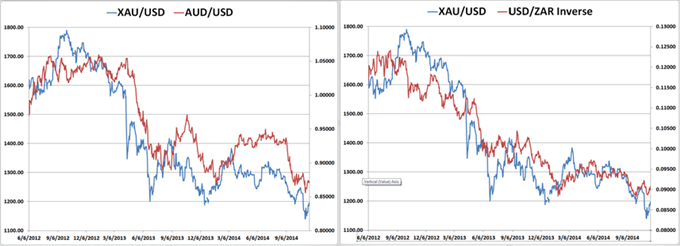Gold Output Declines Amongst Top 5 Producers, Coinciding with Lower Prices
DailyFX.com -
Talking Points
With the Exception of Russia, gold output declined amongst the top 5 producing nations
Gold production is expected to rebound next year and remain Sino-centric in nature
Currencies positively correlated to gold prices depreciated while those with negative correlations appreciated
From its historic inception circa 6000 BC, society has intuitively placed a high value on gold for its intrinsic appeal and monetary value. Originating from the Latin word aurum, gold can be used as medium of exchange or store of wealth among individuals, as a component in commodities for retail purposes, or as a monetary reserve among financial institutions. Owing to its versatility, of the 86 known metals gold remains the most valuable among the antiquity metals –gold, silver, copper, lead, iron, tin and mercury-giving it great economic value to the top five producing nations.
People’s Republic of China
Since undergoing capital market liberalization in the 1990s, China has become the largest producer and consumer of gold, accounting for 26% of global private sector demand. While 2014 is expected to be a year of consolidation, as it follows a year of uncharacteristically low prices and high sales, the gold market is expected to rebound and remain Sino-centric in the near future.
Real incomes are expected to continue rising along with the middle class, whose population is to expand by 200 million in the lead up to 2020. An increasingly urbanized population with vast private savings will thus allow for more exposure to gold as an alternative form of investment. Anticipating this increase in demand, Hong Kong retailer Chow Tai Fook has announced plans to build a 436,000 m² multi-billion dollar jewelry park spanning the spectrum from manufacturing to training and sales. This centralized establishment will add to the preexisting 100,000 jewelry stores.
With an output of 10t per annum at the start of reforms in 1978, gold mining contributed little to GDP. However, domestic production has since increased to 473t per annum, accounting for 14% of global production. Yet, this pace of expansion is unlikely to be sustainable as China only holds 4% of the world’s gold reserves. Chinese demand will thus continue to outpace supply, leaving room for growth in exporting nations. As gold prices have weakened the Renminbi has appreciated against the US dollar as XAU/USD and USD/CNH Inverse have a negative correlation of -0.7285.
Australia
As a top ten export, gold contributes $14 billion per year to Australia’s GDP. In the 2013-2014 financial year, gold was the second most valuable mineral with sales valued at $8.8 billion. This is a figure just 2% off the previous year, as a weaker Australian Dollar was able to offset lower US dollar commodity prices. The largest contributions came from Olympic Dam in SA and Kalgoorlie in WA. No new construction is to be expected next year as investment was down 3% on the year. Long term production however remains sustainable as Australia accounts for 18% of the world’s demonstrated resources. Trending lower alongside gold prices is the Australian dollar, as XAU/USD has a strong positive correlation (0.888163) to the AUD/USD.
Russian Federation
In 2013 Russia surpassed the United States to become the 3rd largest producer, after gold mining increased from 7% in 2012 to 12% in 2013. An extension of this trend was present in the first half of 2014, as gold extraction increased 27% when compared to the same time block a year prior. Contributing to the trend was Polys Gold International Ltd, Russia’s largest gold producer, who reported a 19% increase in Q3 (QoQ) and a 5% (YoY). Increases in production will likely continue as the company remains on track to a launch a new mine, Natalka, in the summer of 2015.
United States
In 2013 mines across the United States produced 227t of gold valued at 10.2 billion dollars. While still a large number by global standards, production was 3% below output in 2012. The downtrend has continued into 2014 with August’s gold production of 18,400Kg down 11% (YoY). Furthermore, Newmont Mining Corporation, one of the world’s largest producers of gold, reported production in Nevada was down 18% on the quarter and 11% on the year. Mining production in Nevada, which accounts for more than 79% of US production, is expected to turn around next year as the Turf Vent Shaft project is reportedly on track to commence capital production at a level of 100-150K ounces a year. With a negative correlation of 0.86499 to the price of gold, as the US dollar has appreciated against several major currencies, purchasing gold has become less desirable sending XAU/USD in the opposite direction of the US dollar index.
South Africa
With a small domestic market, South Africa’s gold industry is largely export oriented with a value of nearly 4 billion US dollars. As home to one of the most prolific mining regions, Witwatersrand or simply “The Rand” ,South Africa accounts for approximately 50% of the world’s gold reserves. Despite possessing a low geothermal gradient, which allows for deeper mining, production decreased by 1.2% from the three months July-September relative to the three months prior. While mining as a whole increased by 7% in Q3, gold mining by volume was down 0.6% with year-over-year mineral sales, at current prices, down 6.3%. Coinciding with this weakness in gold prices was the rand, as XAU/USD and USD/ZAR inverse have a strong positive correlation of 0.825183.
Currencies with a Positive Correlation to Gold
Currencies with a Negative Correlation to Gold
DailyFX provides forex news and technical analysis on the trends that influence the global currency markets.
Learn forex trading with a free practice account and trading charts from FXCM.

 Yahoo Finance
Yahoo Finance 


